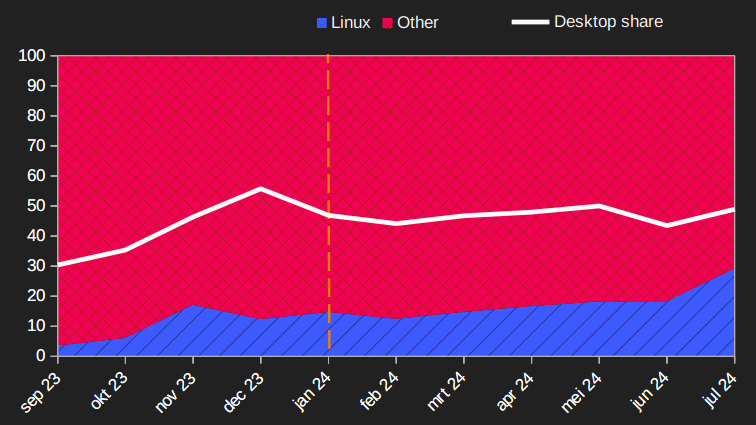1 out of the 3 total norwegian changed the OS after creating a lemmy account.
We’re quite stupid and easy to influence.
Proof in point: I’ve gone from 0 to 3 Linux machines since joining Lemmy.
Someone send help, please??
I can send you an ISO file with more Tux.
Buy Raspberry Pis in bulk and make pointless SBC projects. It’s the only thing that will fulfill you.
Go Pine64
And grab their risc-v model
Or the arm version. They both are good for software freedom
Go Framework
Same here. Maybe that explains it, all linux users just run multiple systems. I dont know many people who use linux certainly not every third person I meet.
Source: æøå
I really want to and at the same time don’t want to know where your name comes from…
I’m thinking koffert straight away
No luggage no worries
Hah, never thought of it like that. I went from 0 to 2 linux desktop machines shortly after joining lemmy.
You laugh but I installed my first Linux distro after leaving reddit and coming here lol.
One must protect their liberty
ironically half my team at work is in Norway and they use windows. My team in the US uses linux.
Are nowegians hate Finland? I don’t have any other explaination for this.
At least us finns only have a rivalry with sweden
They just started counting all my computers and virtual machines on which I run Arch and Nixos btw!
Good choices
Thanks! As I have been learning to love the Nix way of doing things my only regret is missing the great documentation of Arch. Hopefully we can have the best of both worlds in the future!
noice
European governments will do this thing where they pass some law that says they have to take bids from local vendors for systems, olafs computer service will put in a bid with some free software system, the government will take them up on it, spend a bunch of money trying to integrate it into their existing systems with varying degrees of success then parlay abandoning it for their majority provider in exchange for avoiding cost increases or some free support/equipment.
I think Germany’s done it twice now.
The EU requires government acquisitions to be publicly announced so that private companies can make offers that the government then must choose from (not freely, mind you, but following some “objective” metrics).
Even though this might sound great to some, it has the downside of promoting commercial services and vendor lock-in up to the point that even if a free and open source alternative exists, it cannot be used unless there also exists some commercial entity behind it that can sell the software and support for it in accordance with the established metrics.
This might be one of the biggest hurdles in the way for Linux adoption, since anyone can claim to do lots of great stuff with SUPERproprietarySOFTWARETM and then hold critical services, like healthcare mentioned elsewhere, hostage to their failure to deliver on promises and future bad support.
I in general very much support requiring paying for support. I.e. SLAs with consequences for not meeting targets support.
At least for software/hardware running things that can’t afford indefinite unauthorized access or downtime if left in a vulnerable state. (Some stuff actually can IMHO be like that).
I also think governments should have justify renting software insteading buying it if the money is intended to be an investment of any kind.
Even more important, a huge multinational like Microsoft can be forced in court to provide the support they sell under threat of legal action that would cripple their profitability in the region. Olafs computer service will just turn its pockets inside out, flip around the shingle to closed and leave the national drivers license agency in a lurch.
On some level the companies that sell and support systems government relies on have to be treated as nation states themselves in order to maintain normalcy, which both parties “want”.
I think Germany’s done it twice now.
It was Munich and they switched back to Windows after M$ moved their German headquarters to Munich.
That was very funny.
Smelly corruption that was as plain as day
I wish there were more focus on the desktop and app gui side of things on Linux
sure using the terminal to install things is very efficient but some people just want an install button and a gui that they don’t have to use more than 2 braincells to figure out why package not found or some obscure error with an app for the next 2 hours with forum pages full of condescending non answers
thank you for the recommendations!
Those are somewhat niche distros, id personally recommend mint, zorin, pop_os! or what have you.
It really depends on what your usecase and tastes are though.
Niche is relative - they are variants of Fedora, and have been getting very popular very quickly.
Haven’t you just recommended 3 stale Ubuntu variants there?
Miny and pop are often updated, zorin does admittedly have a slow update cycle
I don’t think that’s been an issue for several years now. At least for distros focused on user friendliness.
Flatpak?
I’m a fan of the Flatpak trend. The latest version of Linux Mint has some interesting additions to how things are presented, as far as “verified” and “not verified”. Basically their app installer program lets you know if a particular Flatpak should be treated with caution, sort of like downloading a random .exe with Windows.
I recently installed Manjaro with KDE Plasma, and I’d like an easier way of getting Flatpaks out of the box with it. Their solution is to install Discover alongside their own app installer. So now I have two different GUI programs to open if I want to research something to install.
The idea with flatpaks are flawed by design as everything can’t be there. I want to install the latest version of these there: kde Plasma, wayland, Nvidia drivers, and the Linux kernel. It will never be available there. Better to go back to the drawing board on how to fix this in a good way.
A kernel flatpak? That’d be interesting.
I would be less against flatpaks if you could do everything with it. But it seems to try to slow multiple problems at the same time and failing.
I think it is time to actually come up with a better design solution.
I actually disagree with a couple of changes Mint made regarding Flatpaks. Not showing reviews for unverified Flatpaks especially.
I get it, they want to punish unverified Flatpaks to give them a kick up the arse to get verified. But it also means that if something nefarious is going on with the unverified Flatpak, and Mint hasn’t taken it down yet, users can’t see reviews that might alert them to the app being dodgy.
I know of a number of times I’ve went to download an app on android that I’ve heard of only to see recent 1 star reviews saying stuff like “this has been bought by an ad company and filled with data harvesting and ads”, or “this has been bought by a Chinese government-linked company, beware”. I want to see shit like that, verified app or not.
It’s a similar issue to YouTube hiding dislikes making it difficult to quickly see whether a video guide is helpful/legit or not.
There’s also them disabling unverified Flatpaks by default. I can see why, but at the same time it’s perhaps hypocritical considering any software they package also isn’t packaged by the original software creator, and yet not only is that available by default, but it’s also never marked as unverified.
That said, I’m not that fussed about this one considering that if you’re using Mint in the first place, you probably trust Mint/Canonical and their repositories.
Good point about the reviews. I forgot about that part.
Yeah I definitely don’t want to sound negative on Flatpaks or on Mint, though.
Flatpaks are my preferred way of packaging apps, and while I’ve moved on from Mint for my own usecase (I like Gnome so Fedora made more sense to me), I always install Mint on other people’s old machines because it just works, is similar to Windows UX, doesn’t require you to be on top of updates very much, and has pretty sane defaults.
I’m tired of pandering to people that can’t take the time to learn how to operate a computer. I hate the trend of the last 25 years of making everything “idiot proof”, because it’s not helping people, it’s making them dumber. I remember a time when normal users were expected to set DIP switches on their motherboards and edit autoexec.bat files.
A lot of gen-z doesn’t even know what a hierarchial filesystem is anymore. They just shove all their media into “galleries”, but can’t actually tell you where that file is actually located.
This is the unfortunate reality. My kids (11 and 9) have only ever used Linux distros, and they are keyboard warriors to boot. They say that the only reason to use the mouse is to aim in video games 🤣
I can’t vouch for every Linux distro that claims to be user-friendly, but I’ve fully switched to Linux Mint a couple of months ago, and I’ve had no issues. The only times I’ve used the console are when I want to use it.
My biggest worry before fully switching was playing pirated games, or games that I bought outside of Steam, but using Lutris it has been pretty straight forward.
As a Dane i can say that maybe its because Scandinavians are generally pretty tech savvy and good with digitalisation. Also Scandinavians has a low tolerance for bullshit.
This sounds valid. I wonder how many Scandinavians switched to Linux because of Windows 11.
Well, I’m one. Fed up with windows BS.
You reset their screensaver settings twice, you don’t get to do it a third time
Also, a lot of Scandinavian libraries are switching their public desktop PCs to Linux.
Yup. It’s the reason why Denmark is the most developed country in North America as Canada and the United States worship the aristocrats’ bullshit too much.
Did you seriously just name Denmark a country in North America?!
Denmark shares a land border with Canada on Hans Island also France shares a maritime border with Canada.
You can’t seriously call them “countries in North America” though, that’s just ridiculous.
France is quintessential North America.
/s, /s.
Nothing is happening in Norway. Source: I live in Norway.
I’ve met only a handful people that use Linux on their desktop, plus some developers that use it at work.
I run (one of three partners) a small IT company in the UK. I’ve always Linuxed since around 1998. After messing with RedHat, Mandrake, Yggdrasil and others I settled down and ran Gentoo for many years and then Arch for some more.
I’m gradually dumping the Windows servers and replacing with Linux based beasties. We are also in the throws of replacing VMware with Proxmox.
I also have a pretty decent Kbuntu based desktop/laptop effort. I’ve done Windows client deployments in the 1000s so I have quite a good idea about compliance etc. An Ubuntu based box can run several AV solutions, secure boot and full disc encryption. Buzz words perhaps but also audit points and will get you over the line for Cyber Essentials Plus (UK).
Libre Office works for me and I used to teach office suites in the 90’s! Things have moved on since but a decimal alignment stop is a decimal alignment stop today too (do you know what that means?). I run our Exchange system, and I migrated it from GroupWise back in the day because the kool kids “required” it. Anyway, Evolution with EWS will get you full functionality for a client but with far less faff.
I’m taking my time. I already have at least two employees who are dyed in the wool Windows officianados begging me to migrate them to Linux. I will but it takes time. For example - “drive mappings” or in English: Remote mounts.
CID - https://cid-doc.github.io/ . This is an easy to add Windows compat thing. Its rather good. For static desktops its fine but for laptops that move around a lot it can be hard to get the file system mounts working again quickly in a dynamic environment.
CID uses a PAM mount based system and in the past I used another one (autofs I think). However it seems to me that mounts are not dynamic or responsive enough. In the end it is Samba and that might need some fettling as well.
As I said earlier, I’m taking my time (I’m an engineer) but be assured that Linux is quite capable of driving your desktop.
Then atleast fake it until you make it!
There are dozens of us
Baker’s dozens!
Yes,we know about your small population,but just because Karl uses Linux now,does that really matter?
dozens of dozens!
That’s gross.
I especially appreciate that the graph is designed as “Linux” and “Other” instead of “Windows”, maybe “MacOS” and “Other”.
You know, charts can lie, but with THAT crosshatch? Impossible.
This graph gives me some Corona flashbacks.
I was confused why they used Swedish flag colors for a Norwegian graph
Well you see. 1905 never happened, and we are all under Sweden still. /s
The welfare of the brother peoples.
Why do you all want to rule the world? Just let people who like windows enjoy it… Jesus christ.
“Why do you want to educate people? Just let them live in ignorance of the theft right under their noses… Thor Odinson.” - that’s what you sound like
Why spread a good thing to the world? Just let people enjoy their wiretappy thing… jesus christ.
an attempt at an answer:
more linux users = more linux software (and I know this doesn’t mean better linux software)
Or at least attention from the bigger actors e.g., Adobe, Autodesk etc. to make their industry standards available for Linux users
I’d rather Adobe not do that, but to each his own.
More Linux users =>
- more people looking at source code
- more people potentially paying for development of some OSS Linux software
- More developer time for said OSS software => better OSS Linux software
Hi
For a democracy to work it’s people need to act like political consumers. To do so, they need to be informed about the products they consume and their alternatives.
That’s political consumerism, not democracy.
look at the culture and mindset which Windows™ breeds.
I am wondering, what is enjoyable about Windows/Microsoft?
The slow & buggy UI?
The blue screens due to crappy drivers or bc they fucked something up?
The way they erase any customisability, essentially forcing their users to adapt their vision of how a computer should be operated?
How they are coming up with great ideas such as taking system snapshots and having AI analyze them?
The updates that randomly decide to install and then take an eternity with the end user not being able to use their PC whilst an update is taking place?
The 10.000 different ways of updating software?
How they are blatantly ripping off features whilst marketing them as their own ideas?
The way they are turning it more and more into an advertising platform for their own products?
The $139.00 license fee for everything I just mentioned?
Like, the only enjoyable thing I can think of is software availability but thanks to WINE / Proton this advantage is becoming less and less relevant.
This is reported as a percentage and that’s what is tripping people up here.
You are not seeing a drastic rise in Linux usage you are seeing a large decrease in the use of desktop computers.
Linux is increasing because the only ones left using desktops are Linux users.
Nice explanation but here is a graph with desktop percentage included (versus mobile plus tablet, but that isn’t shown)

One extra Norwegian user in Statcounter’s biased and unrepresentative dataset started to use Linux, probably.
I don’t think it’s that biased and unrepresentative, as Pornhub’s usage statistics show about the same numbers for global Linux usage
Pornhub is legitimately one of the best sites for internet statistics around. It’s very widely visited and they actually put out the numbers. (Although, sadly, in my state of Virginia, they comply with identification requirements, so I only visit it with my VPN active, which then fucks up the stats.)
“Best sites”
Is that where all the government computers run Ubuntu?
I’m a Norwegian Linux enthusiast and have never heard anything about the government using Ubuntu or Linux. Seems unlikely, from what I know. I know that within healthcare Windows is still widely used, even on the server side…
On the other hand, a lot of software for official services is being developed as open source now, so that’s at least a good step in the right direction. Example: https://github.com/navikt
Norwegian government loves windows, so yea, I really doubt it. (by it, I mean the government using Ubuntu thing)
Source: I used to work for the Norwegian government
edit: added explanation to “it”, so not to be as confusing to what I refered to.
You’re thinking of Switzerland
Ah, thanks! I knew it was somewhere.
























